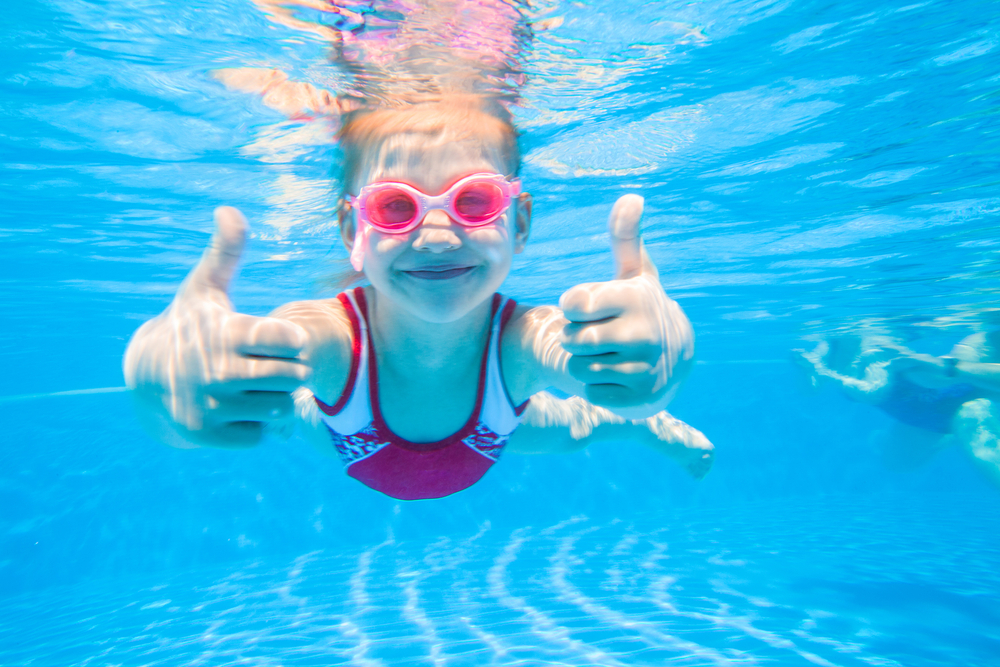As we anticipate enjoying the pool and going on vacation this summer, here are some tips from Let’s Grow Pediatrics to keep in mind as we promote water safety for kids.
How Does Swimming Positively Impact A Child’s Well-Being?
- Full-Body Workout: Swimming is a fantastic form of exercise that engages the entire body. It promotes the development of various muscle groups, including the arms, legs, core, and back.
- Cardiovascular Health: Swimming is an excellent cardiovascular workout. It increases heart rate, improves circulation, and enhances lung capacity. Regular swimming sessions can help children develop a strong and healthy cardiovascular system, promoting endurance and stamina.
- Motor Skills Development: Swimming requires coordinated movements and control of the body in water. By practicing different swimming strokes, children improve their motor skills, balance, and coordination.
- Flexibility and Range of Motion: The water’s buoyancy reduces the impact on joints, allowing for greater freedom of movement. Swimming helps improve flexibility and range of motion as children move their limbs through the water.
- Posture and Body Alignment: Swimming promotes good posture and body alignment. The water’s resistance forces children to maintain proper body alignment to move efficiently in the water. Regular swimming can help improve posture, strengthen core muscles, and reduce the risk of postural imbalances.
- Confidence and Self-Esteem: Learning to swim and improving swimming skills can boost a child’s self-confidence and self-esteem. Overcoming challenges in the water, setting goals, and achieving them provide a sense of accomplishment, leading to increased confidence both in and out of the water.
It’s important to note that children should always be supervised while swimming, regardless of their skill level. Swimming lessons should be conducted by qualified instructors in a safe and controlled environment.
How To Keep Your Children Water-Safe
Children’s natural curiosity and attraction to water require extra vigilance to ensure their safety. Whether you’re spending time outdoors or at home, it’s important to implement effective water safety measures.
1. Be Prepared for Emergencies: Preparing for unexpected situations is crucial. Teach your child how to call 911 in case of an emergency and ensure that all adults and older children in the vicinity are trained in CPR. Being prepared can make a significant difference in emergency situations.
2. Maintain Close Supervision: Keep your child within arm’s reach when they are in or near water. Even momentary distractions can lead to accidents, especially in bathtubs. Maintain constant tactile contact with your child and always be aware of their whereabouts. If you need to leave the water, take your child with you to ensure their safety.
3. Assign a Dedicated Water Watcher: Designate a responsible adult as the “water watcher” whose sole responsibility is to supervise children in or near water. The water watcher should avoid distractions like cell phones or other activities. It’s crucial to trade off with another sober adult to ensure continuous supervision.
4. Educate Your Child on Water Safety Rules: Teach your child about essential water safety rules from a young age. Emphasize the importance of swimming with an adult water watcher at all times and discourage jumping into unknown bodies of water or pushing others in the water. When visiting places with posted water rules, read and explain the rules to your child or encourage them to read them aloud to you.
5. Secure Access to Water: Install fences around pools and use locks on doors leading to pools, hot tubs, and bathrooms to restrict unsupervised access to water. Consider installing pool alarms that notify you if a child enters the water without your knowledge. Additionally, be mindful of containers holding water around the house and empty them promptly. Emptying containers or buckets of water is often overlooked, but this safety step is crucial when you have very young children.
6. Enroll Your Child in Swim Lessons: Starting swim lessons as soon as your child is ready is an excellent way to enhance their water safety. Look for reputable programs, such as those offered by the Red Cross and local gyms like the YMCA. Parent-child water play classes are available for children as young as six months old, providing a comfortable introduction to the pool environment. Consult with your pediatrician to determine the right time for your child to begin swim lessons.
7. Use Properly Fitted Life Jackets: When engaging in water activities, ensure your child wears a life jacket that fits properly and is approved by the U.S. Coast Guard. Avoid relying on air-filled toys or foam devices as substitutes for life jackets. Even with a life jacket, maintain awareness of your child’s whereabouts in the water.
8. Lead by Example: Children learn by observing and imitating adults, especially their parents. Model safe behavior by following water safety rules yourself. Demonstrate that adhering to safety guidelines is an integral part of having fun in and around water.
Remember, consistent supervision, swimming skills, clear safety rules, proper use of flotation devices, and hazard awareness are key to fostering a safe and enjoyable water experience for children. Let’s prioritize water safety and ensure that every water-related adventure is accompanied by peace of mind and joyful memories.
How Can Physical Therapy Benefit A Child’s Development?
At Let’s Grow Pediatrics, we believe that it is important to catch any signs of developmental delays early. We recommend that if a child has a diagnosis with known associated delays, they should seek a physical therapy referral before any signs of delay become apparent. Our evaluations for developmental disabilities and plagiocephaly begin as early as one month of age. To find out more about our treatment options and how your child can benefit from Pediatric Intensive Physical Therapy, reach out to Let’s Grow Pediatrics in Edmond, OK. Call 405-562-3485 to schedule your consultation today.


